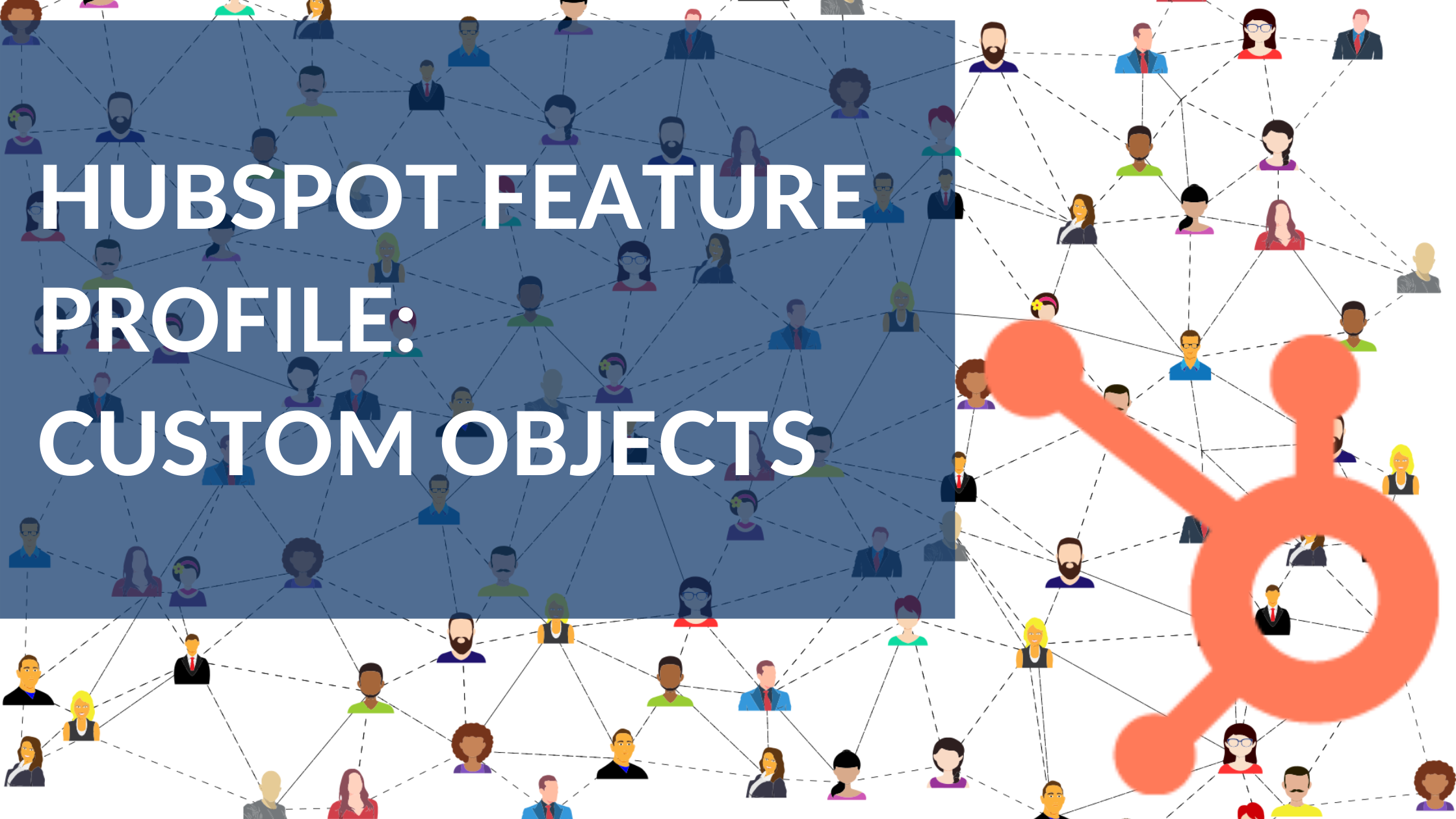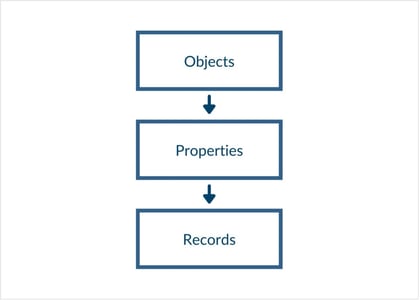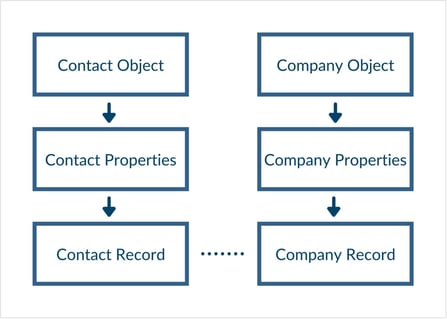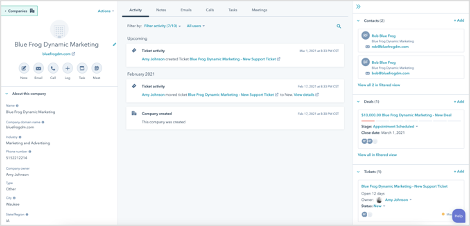
At Inbound 2020, HubSpot announced that custom objects are available to all Enterprise tier customers, meaning any customer with CMS Hub, Marketing Hub, Sales Hub, or Service Hub Enterprise can store any additional data they need in HubSpot with custom objects. Before you or your client moves forward with custom objects, it’s crucial that you evaluate the state of your current CRM data and determine if your data segmentation and reporting limitations warrant custom objects or an alternative solution.
If you’re familiar with custom objects, or you wish to start from square one, this post will walk you through the following topics:
- Review of HubSpot standard objects
- What are HubSpot custom objects and when to use them
- Common use cases for custom objects
- How to create custom objects
- How to manage and use a custom object
- Current limitations to custom objects
Let’s Review HubSpot Standard Objects
At its core, HubSpot helps businesses manage relationships using objects, or a type of relationship your business manages externally. HubSpot’s four standard object types include the following: contacts, companies, deals, and tickets.
Contacts represent the individual people your business works and interacts with; companies represent the individual organizations your business works and interacts with; deals represent the opportunities your business has with specific companies and contacts; finally, tickets represent the customer support requests your business receives from specific companies and contacts.
Within each object type is a set of standard default properties, or fields that can store data. For each object type, you can use HubSpot’s default properties, and create new custom properties to store additional data that’s relevant to your business. Once you identify and build the properties that are unique to your business, you can start inputting information in the different properties for individual records, which are unique instances of one of HubSpot’s four standard object types.

In order to keep track of your business’ relationships with unique records in HubSpot, you can create associations between each of HubSpot’s four standard object types. For example, you can associate a contact with one company (Note: You may only associate one company to a contact record in HubSpot).

One object record, for instance, can have associations with all three other standard object types. Let’s use the company record below as an example (Note: All associations are shown in the right-hand side of the record). The company, Blue Frog Dynamic Marketing, is associated with two contacts: Rob Blue Frog and Bob Blue Frog. Blue Frog Dynamic Marketing is also associated with one deal: $10,000 Blue Frog Dynamic Marketing – New Deal. Finally, Blue Frog Dynamic Marketing is also associated with one ticket: Blue Frog Dynamic Marketing – New Support Ticket.

HubSpot’s standard objects are great for helping businesses manage relationships and create alignment between their marketing, sales, and customer success teams, but what happens when your business or a client’s business needs to define more than just the standard, out-of-the-box relationships? Enter custom objects.
What Are HubSpot Custom Objects?
Custom objects allow you to define your own object when HubSpot’s standard objects don’t quite meet your CRM segmentation and reporting needs. They function like HubSpot’s standard objects in that you can create your own custom object properties and define the associations that your custom object can have with other custom or standard objects in HubSpot.
Common Use Cases for Custom Objects
Depending on your industry, custom objects may solve your business’ CRM data segmentation and reporting limitations. Remember, custom objects are currently only available to HubSpot Enterprise customers. Below are a few common scenarios in which custom objects can help businesses more accurately represent how they manage their business processes and relationships.
Professional Services Industry: Real Estate Listings
Real estate agents tend to work with multiple listings, or properties, that can each have potentially more than one offer submitted. HubSpot’s standard objects (contacts, companies, deals, and tickets) may not give a real estate agency the best picture in terms of which listings are associated with specific buyers who are willing to offer $X, $Y, and $Z amounts for the listing.
In this situation, a real estate agency could create a custom object called “Listing”, and each property, or listing, would represent a unique Listing object record. This solution would allow the real estate agency to associate multiple offers, or deals, with the same listing. This would also allow the real estate agency to associate the buyer, or a contact, with the listing once the sale processes.
With this Listing custom object, the real estate agency could also create custom properties to help them monitor the status of their listing database and what type of inventory they have available. For example, they could create properties for listing status (e.g. For Sale, Under Contract, etc.), number of bedrooms, number of bathrooms, location, etc., and when the real estate agency begins working with a potential buyer, they could filter their Listing object records by the listing’s status and buyer’s needs and wants for their future home.
Manufacturing Industry: Factory and Plant Inspections & Site Visits
Manufacturers oftentimes follow a protocol for regularly scheduled inspections and site visits. However, HubSpot’s standard custom objects may not give them the best functionality to record every site visit and their outcome. Using HubSpot’s custom objects, a manufacturing company could create a custom object for “Site Visits” to track each inspection or site visit as a unique object record that they can associate with the point of contact, or contacts, for the scheduled site visit, as well as the location, or company, where the site visit will take place.
The manufacturing company could also create custom Site Visit properties to monitor the outcome of the site visit and determine next best steps. Based on the data inputted, the manufacturer could use several of HubSpot’s other tools like reports or workflows to monitor the schedule and status of site visits by company, and create automations that could help them assign tasks to site visit inspectors, or owners of a specific Site Visit record.
You can review more common custom object use cases in this document made available to the public by HubSpot.
How to Create Custom Objects
As of now, the only way you can define a custom object is via an API, so you will need the help of a developer to properly configure your custom object before you can take any action within HubSpot. To learn how to get started, you can review HubSpot’s developer documentation for CRM Custom Objects.
How to Manage & Use A Custom Object
Once you’ve worked with a developer to define your custom object via API and verified that you have Custom Objects Access, you can start working with your custom object in HubSpot! Similar to HubSpot’s standard objects, your newly created custom object will have its own custom object home on desktop where you can create custom object records, edit custom object properties, and segment your CRM data by specific custom object properties. From your custom objects home on desktop, you can also bulk edit records. Within HubSpot’s property settings, you can create and edit your custom object properties and set the appropriate field types, so your data inputs align with your desired CRM segmentation and reporting goals (Note: Score and File field types are not available for custom object properties).
On HubSpot’s mobile app, you can only view custom object records that you have already associated with existing standard object records. When you view a custom object record in the app, you can only read the custom object property values; editing custom object properties within the app isn’t supported at this time.
Aside from working with your custom object in the custom objects home, there are also several HubSpot tools that will work directly with your new object.
Make Calls from A Custom Object Record
If your business uses HubSpot’s calling tool, good news, you can also make calls from a custom object record. However, there are a few limitations, so it may be worth waiting for the tool to evolve before using this feature with full force. Specifically, you can’t make calls from a custom object if you use a third-party calling provider. You can also only choose to make calls from the associated records that are listed in the Call dropdown menu of your custom object record. No worries, though! If you don’t see the number you’re looking to call on your custom object record, you can always navigate to any associated records (e.g. contact or company) and make your call from the associated record instead.
Use Custom Objects in Workflows
If you have a HubSpot Enterprise license, hopefully you’re already taking advantage of HubSpot’s workflow tool. With custom objects, you can also use workflows to perform several different actions. For example, you can use contact-, company-, deal-, or ticket-based workflows to create new custom object records via the workflow (Note: Your custom object must have a defined relationship with the standard or other custom object-based workflow in order to create a new custom object record via the workflow).
With custom objects, you can also create custom-object-based workflows, meaning you can enroll your custom object records that meet specific enrollment criteria into a workflow.
Use Custom Object Personalization Tokens in Marketing Emails
If you’re on Marketing Enterprise and use HubSpot’s email marketing tool, this feature’s for you. Similar to how you can use contact and company personalization tokens in your marketing emails, you can also use custom object personalization tokens. With this feature, you can pull in relevant information stored in your custom object properties, right into your marketing emails!
Report on Your Custom Objects
Finally, one of the most important features you can use custom objects with is HubSpot’s reports. Pulling your custom object data into reports can give your business insight into the data you were missing or couldn’t report on before custom objects. It’s important to note that you can only create single object reports with custom objects at this time.
Current Limitations to Custom Objects
Since HubSpot’s custom objects are still relatively new, there are a few limitations that you may run into, so it’s import that you’re aware of them before you start defining any custom objects.
There’s a Cap on Objects & Records
Regardless of your Enterprise license type, you can have up to 10 custom object definitions and 500,000 custom object records. If you need additional custom objects or records, you can purchase a Custom Objects Limit Increase pack directly from HubSpot or through your agency partner for $500 per month. This will give you access to define 10 more custom objects and 500,000 more records across all of your custom objects. You can also purchase more than one limit increase pack.
Limited Functionality in HubSpot’s Mobile App
Currently, accessing your custom object through HubSpot’s mobile app is in Beta, and you can only view custom object records that you’ve already associated with existing standard object records. As custom objects continue to evolve, hopefully this is an area where HubSpot makes improvements like allowing users to create new custom object records and make associations right from the HubSpot mobile app.
Personalization Tokens in Templates
While it’s great that personalization tokens are available in the email marketing tool, it would be neat to see HubSpot expand this feature to other tools like Templates. This way, sales reps or customer success teams could pull in specific custom object personalization tokens into email templates to provide additional value to their recipients.
Cross-object Reporting
I’ve heard rumors of cross-object reporting for custom objects, so hopefully we’ll see this roll out soon. Cross-object reporting would give teams even more insight into the data they couldn’t report on before custom objects. For example, they could report on deal properties against custom object properties. Let’s take our real estate agency example from earlier, if the real estate agency had a custom object property for listing type (e.g. single-family home, townhome, condo, luxury, etc.), they could report on the amount of ‘Closed Won’ deals by listing type.
Lists
Finally, the last limitation I wanted to call out is pulling lists by association. It’s not currently possible to pull a list of custom object records associated with a specific contact, company, deal, or ticket record, and vice versa. This is an important feature that will help many teams to properly segment their CRM data in HubSpot, so I’ll be keeping my eyes on this update!
While HubSpot custom objects have some room for improvement, this new feature is already helping teams to further define their relational data within HubSpot. As HubSpot continues to evolve custom objects, be sure to check back here for updates, and if you enjoyed this post, I encourage you to subscribe to our blog for similar content!
Many users looking for custom objects are also looking for an alternative to or integration with SalesForce. If you're looking for more information about the HubSpot-Salesforce integration, check out the link below.


